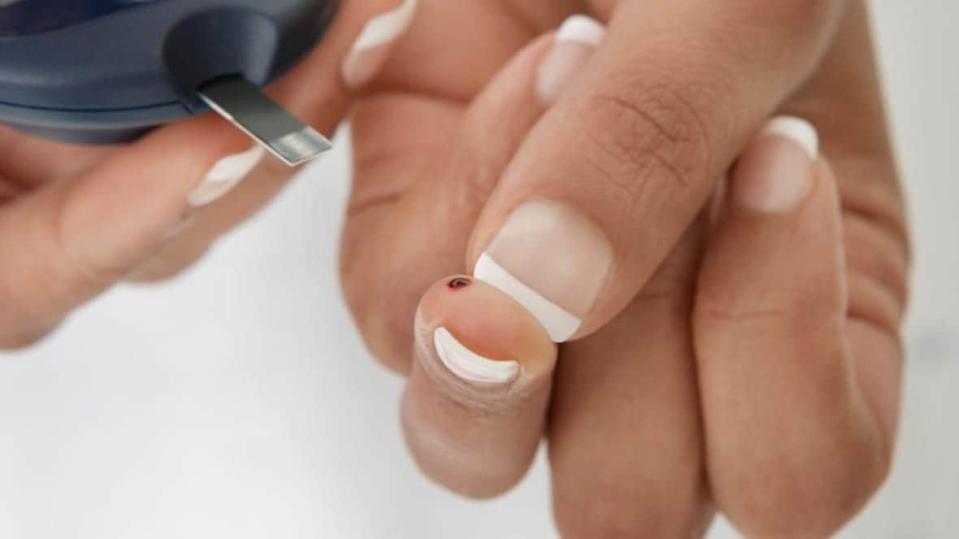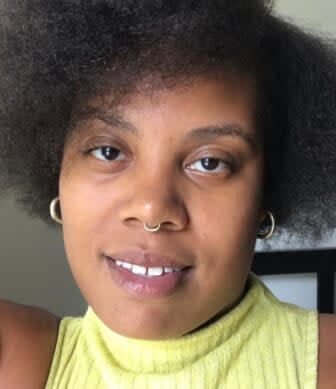What everyone should know about living with diabetes
Two Black women share their stories of living with diabetes — a disease 96 million Americans are at risk of developing but few discuss.
A diabetic’s typical day, if such a thing exists, often starts the night before. A daily routine can involve eating a healthy dinner, consuming enough water before bed, waking up multiple times to check glucose monitors and for a lifesaving sip of juice or bite of a snack, and finally saying a prayer that everything they’ve done will keep their blood sugar level stable enough to get some sleep. All of that, to once again be at the mercy of the disease upon waking.

Or at least, that’s the experience of Ivory Bennett, a Black woman and educator living in Texas who has been living with Type-1 diabetes since she was 16 years old.
“It’s like having a newborn baby that doesn’t ever grow up. It just needs you. It wakes you up in the middle of the night. It’s 24 hours a day, seven days a week,” Bennett said in a phone interview with theGrio.
Bennett is one of 37.3 million individuals living with diabetes in this country. The Centers for Disease Control and Prevention (CDC) defines diabetes as a chronic health condition that affects how your body turns food into energy. The body naturally produces the hormone known as insulin, which converts sugars from food into energy that the body uses or stores for use later. When you have diabetes, this vital process malfunctions in either one of two ways. A person can be diagnosed with either Type-1 diabetes, which occurs when your body can’t produce insulin, or Type-2, when your body doesn’t use insulin properly.
Speaking over Zoom with theGrio for Diabetes Awareness Month, Dr. Otis Kirksey, the American Diabetes Association’s president of health care and education, explained that the disease is genetic. There are roughly 96 million American adults who have what is known as “prediabetes” — yet at least eight in 10 adults don’t even know they’re at risk.
“You need to know your family history. Because you can do all of the right things and still get diabetes, unfortunately,” Kirksey said.
Bennett said when she was diagnosed with Type-1 as a teenager, it came as a complete shock because she was at the pinnacle of physical wellness. She had learned at the age of 12 that she was at risk of developing Type-2 diabetes and took strides on her own to prevent it. She taught herself how to eat healthily, became extremely active in sports, dance and theater in school, and she lost over 50 pounds in the process.
“[Developing diabetes] was my worst fear, which is why at 12, I was motivated to get healthy and lose weight and do all of those things because I thought I had the power to change things — but I ultimately didn’t,” Bennett said.
While a family history of diabetes is among the most common ways to develop it, in some rarer instances, a person can develop the disease as a reaction to an autoimmune disorder or as the result of an illness. This was the case for Dalyce Wilson, a Black woman living in California who has been living with Type-1 diabetes since she was seven years old.
Speaking to theGrio by phone, Wilson recalled developing the disease following a severe bout of the flu that left her fearing for her life as she battled the virus. Looking back on it now, she credits that illness for leaving her young body forever changed.
“I believe that when I got the flu, my body attacked itself and my pancreas,” Wilson said.
For both Bennett and Wilson, life with diabetes has had twists, turns, pits and peaks. Wilson remembers an immediate change in her lifestyle while Bennett said she “honeymooned” for roughly a year before the impacts of the disease really began to set in.
“Don’t let anyone tell you that living with diabetes is easy. It’s expensive. It can be overwhelming,” Dr. Kirksey said, noting that it is treated through insulin and food.
“If you can’t afford the medications you can’t manage the disease,” he said.
Wilson said today it costs roughly $6 to create insulin while the life-saving medication is sold to patients for upwards of $300. Though she maintains a healthy weight, Wilson also said her grocery bill can be as much as a family of four.
As Kirksey also noted, many living with diabetes face living in what is commonly known as “food deserts”; regions devoid of decent grocery stores with healthy foods at affordable prices or restaurants that aren’t fast food.
Stressing how integral access to quality foods is in managing diabetes, Bennett said, “I don’t think people think about care for us in that way.”
Wilson, who grew up in Maryland, shared how living with diabetes can also contribute to feelings of self-consciousness. She wears thick socks in the middle of summer to keep her feet warm, wears a device that beeps when it detects changes in her blood sugar levels, has had to administer self-care in public, has experienced medical emergencies — including passing out in social settings — and has to give anyone new in her life a heads-up.
“Imagine having something that everyone needs to know about but you don’t always want to talk about. You have to bring it up in every social situation. You have to bring it up in job interviews, you have to bring it up when you’re dating, you have to bring it up when you’re traveling,” she said.
What’s worse is how often people with diabetes are not met with understanding from others. Both Bennett and Wilson can attest to how often they have been misunderstood or blamed for the complications that their condition causes. But despite doing everything by the book perfectly to a T, a person with diabetes cannot always control how their blood sugar levels will manifest.
To this point, Wilson said she has sometimes been asked why she didn’t monitor her blood sugar or why she didn’t take insulin in time, or why she didn’t plan better — and the response is always that she did.
“Say it’s a hot day, that’s going to affect our blood sugar. [I could be on my] period, so being a woman and being hormonal will affect my need for insulin,” she said.
This lack of understanding and compassion can also lead to serious systemic issues, including challenges in job security. Wilson said when she’s experiencing low blood sugar it feels similar to being intoxicated and makes her feel unsafe getting behind the wheel whether she has to meet up with a friend or get to work.
“There’s been times where I’ve had continual lows which meant continual [lateness]. I’ve had to explain that to supervisors and they just did not have empathy, or perhaps they did have empathy but they were more focused on the rules and the regulations and the red tape,” she said.
Despite being a Type-1, Bennett said she has even experienced blame for her childhood diagnosis because she is bigger-bodied.
“The assumption that we don’t care, the assumption that we are fat and need to lose weight, the assumption that we eat candy too much, or the assumption that we can’t eat candy at all,” she said. “They blame us so much for this insidious suffering that we experience and it is literally a genetic condition, it is literally an issue of a malfunctioning or maladaptive pancreas.”
Bennett, who grew up in foster care in Pennsylvania and endured aging out of the system at age 21 during an already tumultuous year in college, has also experienced blame and shame from medical practitioners for other factors such as stress that can complicate her diabetes.
“Doctors used to be like ‘Well, stop stressing out about stuff.’ I’m a Black woman in foster care with no support, how you can tell me to stop stressing out? Eradicate racism,” Bennett said.
Dr. Kirksey said one of the barriers to care many diabetics experience is access to quality health care.
“The health care system can be so intimidating, particularly for low-income marginalized communities. They already feel threatened. They’re also fearful and they don’t trust,” he said.
Wilson said everything a diabetes diagnosis comprises can compile into a situation that is very isolating. However, she also said there is a community if you search for it. Wilson first saw a glimpse of this when she attended a summer camp for diabetic children in her youth. She found it again when she met Bennett in college. Bennett noticed her insulin pump in a freshman math class and the two quickly developed a friendship each cherishes to this day.
Both women have found a sense of community online and through their own diabetes advocacy work.
“It’s been great to tap into the online community because that’s where I learn a lot of life hacks and get that emotional support,” Wilson said.
Wilson has also found a way to find and share resources online through mutual aids that work to get insulin and other supplies to those in need at decent prices. She said they can come in handy when traveling to a new city and you run into trouble.
Wilson added that for just about anyone living with a disability, there’s a mental health and emotional component that isn’t always discussed or accommodated. Living with diabetes can result in significant trauma, from panicking about blood sugar levels to anxiety about how any given day is going to go.
“Something that I’ve realized has helped is I’ve tapped into therapy. It’s been necessary for my life,” Wilson said.
With diabetes, the silver lining, whether it be people you wouldn’t have met otherwise or a new outlook gained, isn’t always easy to see when stacked up against the bad the disease can bring. Still, Bennett said embracing her diabetes has enabled her to both be more present and begin to heal from childhood trauma.
“I’m not saying that I’m having the time of my life,” she said. But [I’m] learning how to really appreciate and being present with everything as it is and learning what is truly important—and everything else can be gone by the wayside.”
For more information and resources for those living with and working with patients who have diabetes, please visit diabetes.org

Kay Wicker is a lifestyle writer for theGrio covering health, wellness, travel, beauty, fashion, and the myriad ways Black people live and enjoy their lives. She has previously created content for magazines, newspapers, and digital brands.
TheGrio is FREE on your TV via Apple TV, Amazon Fire, Roku, and Android TV. TheGrio’s Black Podcast Network is free too. Download theGrio mobile apps today! Listen to ‘Writing Black’ with Maiysha Kai.
The post What everyone should know about living with diabetes appeared first on TheGrio.

